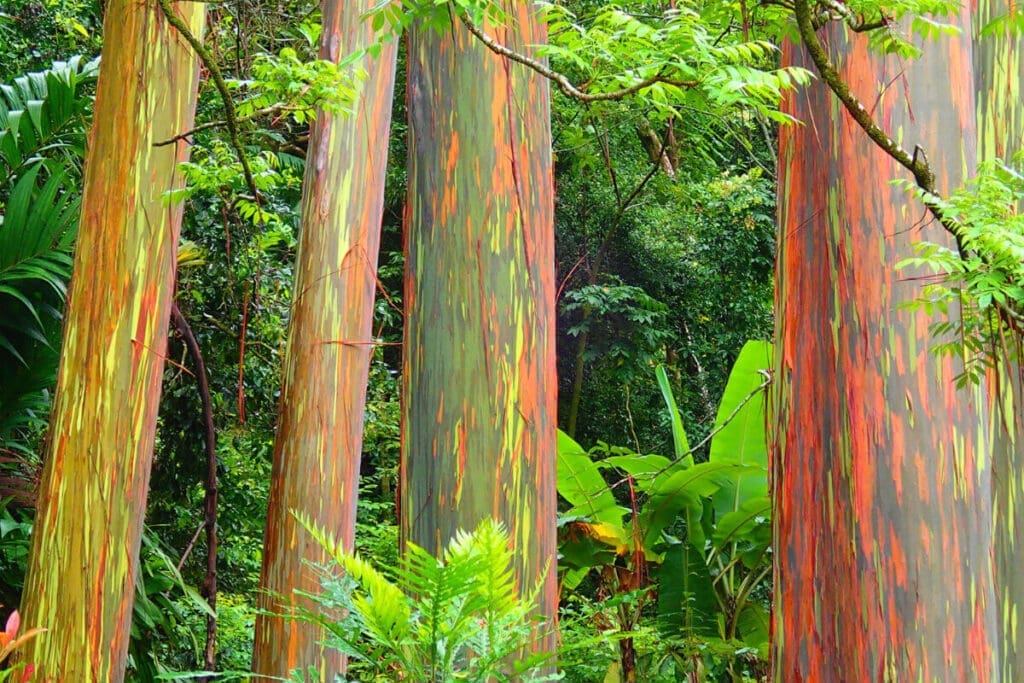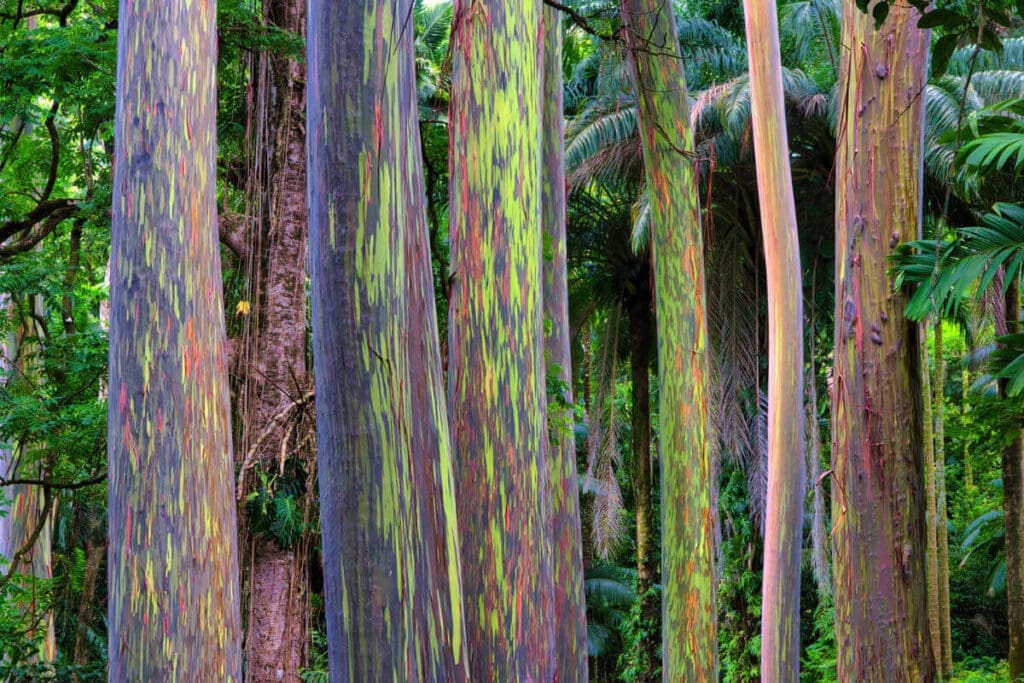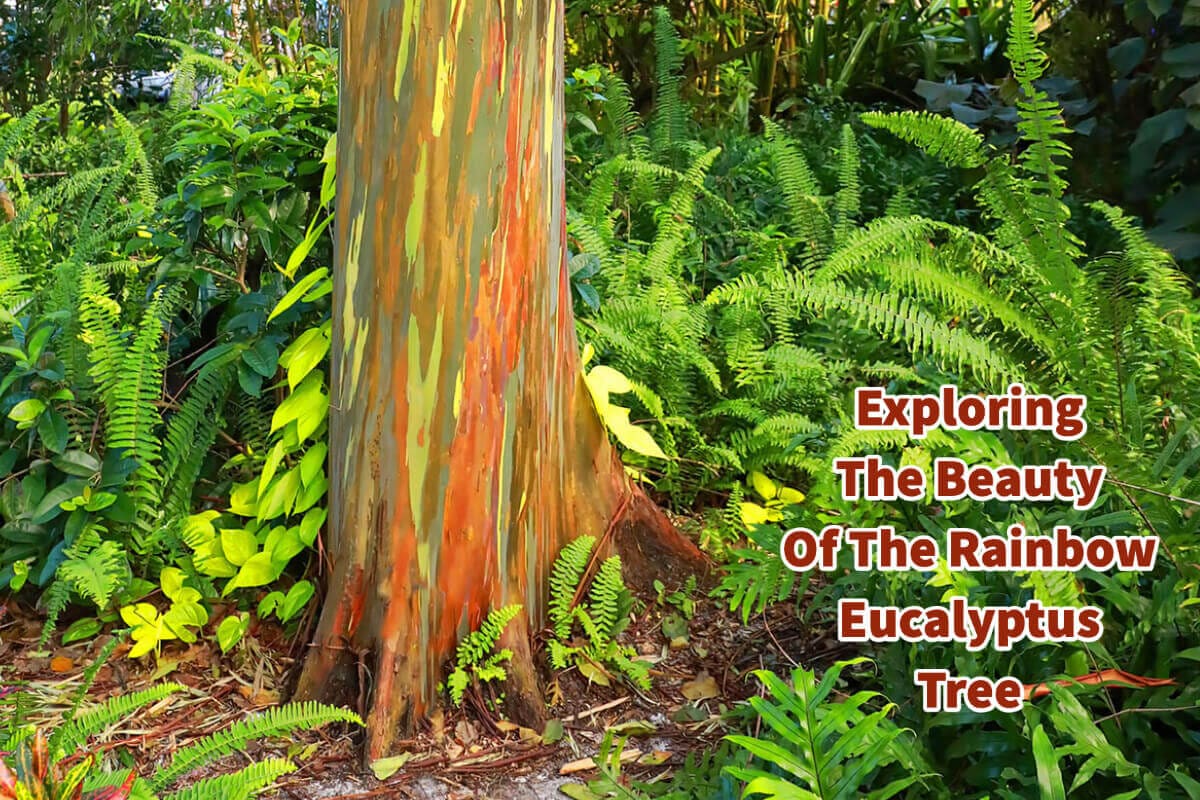Nature’s artistic prowess knows no bounds, and the rainbow eucalyptus tree is a testament to its boundless creativity.
With its mesmerizing multicolored bark and towering presence, this unique species, scientifically known as Eucalyptus Deglupta, has captured the hearts and imaginations of many. Read on as we embark on a journey through the captivating world of the rainbow eucalyptus tree, uncovering the secrets of its colorful exterior and delving into its remarkable characteristics.
Table of Contents
- The Spectacular Beauty Of The Rainbow Eucalyptus Tree: A Colorful Marvel In Nature
- Pros And Cons Of The Rainbow Eucalyptus Tree
- Related Content
The Spectacular Beauty Of The Rainbow Eucalyptus Tree: A Colorful Marvel In Nature
Nature has a way of surprising us with its extraordinary creations, and the rainbow eucalyptus tree is one of nature’s most spectacular beauties. This magnificent tree, scientifically known as Eucalyptus Deglupta, is a unique and awe-inspiring species with its stunning appearance and fascinating characteristics.
The Outside Of The Rainbow Eucalyptus Tree: A Colorful Display Of Nature’s Palette
The most striking feature of the rainbow eucalyptus tree lies in its bark, which undergoes a mesmerizing transformation as it ages. When the bark is young, it appears as a pale green or cream color, gradually transitioning to shades of blue, purple, orange, and maroon.

As the bark matures, it sheds in thin strips, revealing the vibrant colors underneath. This ever-changing bark is a spectacle, resembling an artist’s brush strokes on a living canvas.
No wonder these trees have earned the moniker of “rainbow eucalyptus.”
This unique coloring process occurs due to the shedding of patches of bark, which exposes the fresh, bright-green inner bark. As the exposed bark ages, it transforms into various hues, creating a remarkable spectacle of colors along the trunk.
The vibrant palette results from pigments such as tannins, chlorophyll, and terpenoids, which give rise to the rainbow-like appearance. This natural phenomenon makes the rainbow eucalyptus tree a visually stunning addition to any landscape, evoking a sense of wonder and enchantment.
The Inside: A Journey Through The Rainbow
While the exterior of the rainbow eucalyptus tree captures our attention, its interior also holds remarkable attributes.
The tree belongs to the Myrtle family and can grow to towering heights, reaching up to 250 feet (76 meters). Its leaves are elongated, lance-shaped, and possess a leathery texture.
The foliage, typically a glossy green, remains on the tree year-round, providing shade and attractive foliage throughout the seasons. This characteristic sets the rainbow eucalyptus tree apart from deciduous trees, making it a popular choice for landscaping purposes.
Pros And Cons Of The Rainbow Eucalyptus Tree
The Rainbow Eucalyptus tree is grown mainly for landscaping purposes. It is popular in many large-scale commercial projects.

Let us explore some of the key benefits of incorporating these trees into various settings:
Pros And Advantages Of The Rainbow Eucalyptus
Drought Tolerance
These trees exhibit remarkable resilience to drought conditions once they are established. Their ability to survive and thrive in arid environments makes them ideal for regions prone to water scarcity.
Evergreen Foliage
Unlike many other tree species that shed their leaves during autumn, the rainbow eucalyptus retains its foliage throughout the year. This attribute ensures a continuous supply of shade and visually appealing greenery, enhancing the aesthetic appeal of any landscape.
Disease And Pest Resistance
Rainbow eucalyptus trees are relatively resistant to diseases and insect pests, making them easier to maintain and reducing the need for extensive chemical treatments.
Rapid Growth
These trees have a commendable growth rate, allowing them to establish themselves quickly and provide desired landscape features within a relatively short period. This characteristic is particularly advantageous in large-scale projects that require fast results.
Low Maintenance
Once established, rainbow eucalyptus trees require minimal care, making them suitable for busy landscapes or areas with limited resources for maintenance. Their self-sufficiency adds to their appeal as a landscaping choice.
Despite their many advantages, it is essential to consider the potential drawbacks of incorporating rainbow eucalyptus trees into specific environments. Let us now explore some of the potential disadvantages of these trees:
Cons And Disadvantages Of The Rainbow Eucalyptus Tree

Height And Space Requirements
Rainbow eucalyptus trees have the potential to grow to tower heights, making them unsuitable for small yards or areas with overhead electrical wires. Proper consideration of available space is essential before planting these trees.
Bark Shedding
One notable drawback of rainbow eucalyptus trees is their propensity to shed bark, particularly during autumn. The shedding occurs in large chunks, which can fall unexpectedly and cause potential hazards. Parking vehicles under mature trees can result in damage due to falling bark.
Leaf Litter
Rainbow eucalyptus trees shed leaves throughout the year, creating a mess in the surrounding area. Regular cleaning and maintenance may be required to keep the landscape tidy.
Branch Shedding
Although seemingly healthy, mature rainbow eucalyptus trees have been known to shed branches unexpectedly. The size of these branches can pose a significant risk to individuals, potentially causing severe injury or even death.
Flammability
Rainbow eucalyptus trees fall on the more explosive end of the tree flammability spectrum. In areas prone to wildfires, the presence of these trees should be carefully considered, and appropriate precautions should be taken to mitigate the risk.
The rainbow eucalyptus tree is a testament to nature’s boundless beauty and diversity. Its vibrant and ever-changing bark, majestic stature, and low-maintenance characteristics have made it a popular choice for landscaping and large-scale commercial projects.
However, weighing the advantages against the potential drawbacks is crucial before incorporating these trees into specific environments. By considering factors such as space requirements, bark shedding, leaf litter, branch shedding, and flammability, one can make informed decisions regarding including rainbow eucalyptus trees in their landscaping endeavors.
As long as proper precautions are taken, the rainbow eucalyptus tree will continue to enchant and inspire with its breathtaking colors and natural grandeur.
Find out more about how Mondoro can help you create, develop, and manufacture excellent home decor and furniture products – don’t hesitate to contact me, Anita. Check out my email by clicking here or become a part of our community and join our newsletter by clicking here.
Mondoro gives out a FREE Lookbook to anyone interested. You can receive a copy of our latest Lookbook by clicking here.
Listen to our Podcast called Global Trade Gal. You can find it on all major podcast platforms. Try out listening to one of our podcasts by clicking here.
Subscribe to our Mondoro Company Limited YouTube Channel with great videos and information by clicking here.
Related Content
Is Teak a Coniferous, Evergreen, or Deciduous Tree? 11 Teak Wood Facts
Teak is a deciduous, not evergreen or coniferous tree. Teak leaves do not fall off in the wintertime, but they fall off in the dry season; in Asia, where teak trees are naturally grown, the dry season is not always the same as winter. As the teak leaves do fall off, the tree is considered to be a deciduous tree.
You can discover more by reading Is Teak a Coniferous, Evergreen, or Deciduous Tree? 11 Teak Wood Facts by clicking here.
What Are The Types Of Wood Used In Furniture?
Wood for furniture is divided up into hard and softwood. Though the woods have some similarities, they also have some differences. Different looks and types of furniture may require a certain kind of wood. Some wood species will be higher priced, and others will be cheaper; price, durability, look, color, finish, and structure can decide what wood to choose for your furniture piece.
You can read our blog on What Are The Types Of Wood Used In Furniture? by clicking here.
What Does The Inside Of A Rainbow Eucalyptus Tree Look Like?
The rainbow eucalyptus tree’s wood is very similar to other eucalyptus woods. The rainbow effect of the tree is on the bark only and does not go inside the wood or inner part of the tree. The rainbow eucalyptus tree is native to Southeast Asia. Still, there are many places you can now see the trees in the United States, especially in Hawaii, Florida, and Southern California.
You can learn more by reading our blog, What Does The Inside Of A Rainbow Eucalyptus Tree Look Like? by clicking here.

